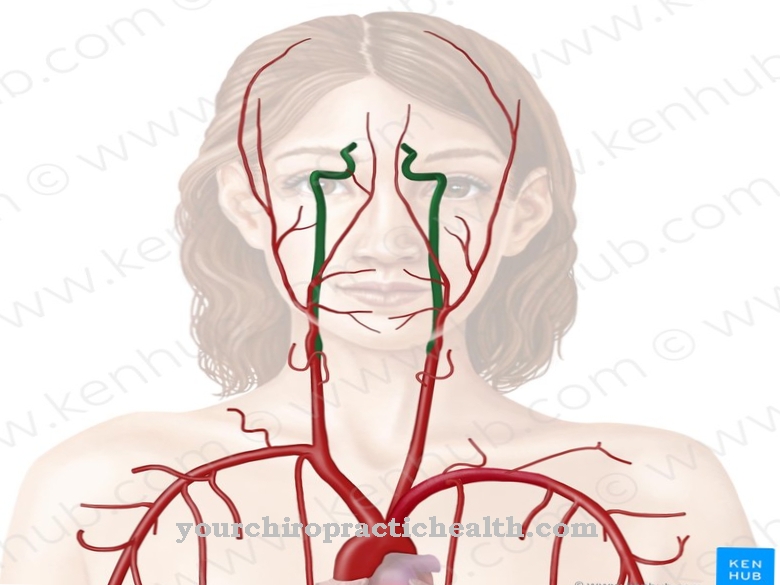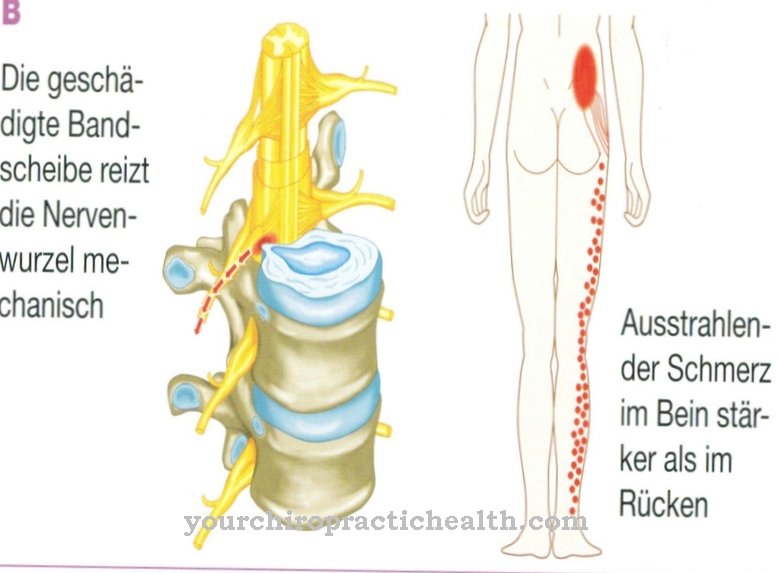As Dentine becomes the human Dentin designated. It forms an extensive part of the tooth.
What is dentin?
In dentin (Substantia eburnea) is bone-like tissue. An important part of the tooth is formed by it. It is also called dentine.
The dentin is located below the tooth enamel. The difference to tooth enamel is u. a. in the fact that the dentine can form anew throughout life, which takes place in the context of biomineralization. However, the new formation only takes place in the border area to the pulp. Dentine is one of the most continuous organic substances.
Anatomy & structure
The dentin extends from the crown area towards the tooth root. In the tooth root region, the dentin is surrounded by dental cement. The dentin in the pulp region is called “pulpal dentin” in dentistry. Its mineral content is lower in the enamel area.
The dentin is built up from a dense network of collagen fibers. This contains calcium salts such as hydroxyapatite. The high degree of mineralization shows values of around 70 percent. In contrast to tooth enamel, dentin is living tissue. Its supply and nutrition is guaranteed by the fine dentine canals. These radiate into the dentine from the pulp. The odontoblastic processes are also located within the canals.
The odontoblasts ensure that the dentin is created anew throughout life. The odontoblasts are located on the edge of the dentin. Further material can be formed from them via Tomes fibers. This is called secondary dentine. It is made after the tooth formation is complete. A topographical distinction must be made between the root dentine, which is surrounded by dental cement, and the crown cement, which is covered by the enamel.
From a structural point of view, there are other forms of dentin. This includes u. a. the coat dentine. It is located 10 to 30 µm below the tooth enamel. In this it is not the odontoblasts, but the mesenchymal cells of the dental papilla that are responsible for the formation of the dentin. The collagen fibers here are considerably larger than the b-fibrils that are created by the odontoblasts.
The main part of the dentin is made up of the circumpulpal dentin. In terms of time, its manufacture takes place after the coat dentine. The mineralization of the dentin proceeds in cycles, resulting in a typical line pattern that is called Eber lines. Therefore, the circumpulpal dentin is also known as Ebner dentin.
Other forms of dentin are peritubular dentin, which is formed in the inner wall of the small dentinal tubules, intertubular dentin, which is located between the tubules, and globular dentin. The latter is the name given to the mineralization zones within the dentin, which have the shape of spheres.
The composition of dentin consists primarily of phosphate, collagen and calcium. It also contains water and organic and inorganic substances.
Function & tasks
One of the functions of dentin is to protect the pulp, which is inside the tooth. The pulp is in turn equipped with connective tissue, nerves as well as blood and lymph vessels. The dentin canals of the dentin also have the ability to transmit stimuli such as temperature or pressure to the tooth nerves.
While the primary dentin forms during the tooth formation, this is the case with the secondary dentin afterwards. However, the secondary dentin increasingly constricts the pulp cavities. This process, in turn, leads to a reduction in the sensitivity of the tooth nerves. If the teeth are damaged, such as caries, periodontitis or bruxism (teeth grinding), tertiary dentin is formed in the affected areas. Its job is to ensure the protection of the dental pulp.
You can find your medication here
➔ Medicines against tartar and tooth discolorationDiseases
The human dentine can be affected by various ailments. This primarily includes tooth decay (tooth decay). With the participation of microorganisms, damage to the tooth enamel and dentin occurs.
While initial caries, the preliminary stage of the disease, only affects the enamel, there is already a risk of toothache with dentine caries (caries media). The caries penetrates from the enamel to the dentin. The dentin is significantly softer than the tooth enamel. Because of this, tooth decay can spread more rapidly below the enamel-dentin boundary. It is not uncommon for the tooth enamel to break in at the edges of the affected areas as a result of chewing. In the further course, the caries can penetrate the dentin to the tooth pulp and finally to the tooth nerve, where it causes considerable discomfort.
Another problem is the exposure of the dentin. This can come about through increasing age and the associated decrease in the gums on the tooth neck. However, inflammation of the gums also often causes the gums to retreat. The exposed dentin is usually noticeable through sensitivity to warm and cold temperatures as well as sensitivity to pain when consuming warm, cold, sweet or sour dishes. Punctual discoloration of the dentin is also possible.
Because dentin is softer than tooth enamel, harmful bacteria spread quickly in the dentin when damage occurs. A dental examination should therefore be carried out immediately if problems with the dentine are suspected. This allows the dentist to identify possible lesions on the dentin and treat them accordingly. The care and cleaning of the dentin is also extremely important. The sooner a dentin therapy is carried out, the greater the chances of success.









.jpg)



.jpg)



.jpg)







.jpg)


